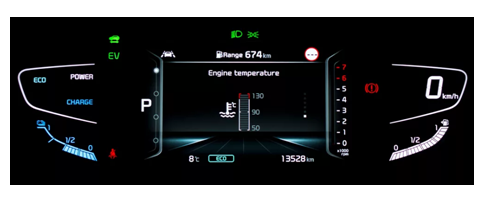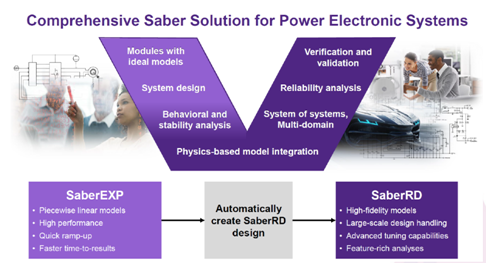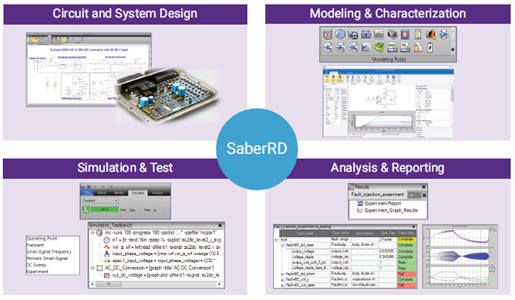
Overcoming Electric Vehicle Design Challenges with SaberRD
Introduction: Addressing Electric Vehicle Design Challenges
Designing electric vehicles (EVs) comes with unique challenges, from optimizing battery performance to ensuring efficient power distribution. However, most of these hurdles can be overcome with the right tools and technologies, paving the way for a more sustainable future. In partnership with Synopsys, EDS Technologies offers SaberRD, which addresses some specific design challenges EV manufacturers face. In this blog, we will discuss some challenges and explore key features that can address these challenges.
The Complexities of Electric Vehicle Design
Designing electric vehicles brings new challenges compared to traditional combustion-engine vehicles. The complexities lie in the powertrain and battery systems and other crucial components such as motor controllers, sensors, and charging infrastructure.
Driving Range
One of the primary concerns in EV design is range anxiety. EV manufacturers strive to extend the range of their vehicles to alleviate customer concerns about running out of power. Achieving a balance between range, battery size, and weight is a delicate task that requires advanced modellingand simulation tools.

Charging infrastructure
In the future, we expect improved charging infrastructure and faster chargers to make electric vehicles (EVs) competitive with gas cars. Long-distance travel poses a challenge due to sparse charging stations along routes. While expanding this infrastructure requires significant investment, daily recharging in home garages, workplaces, and commercial areas could eliminate the need for regular stops at filling stations for EV drivers.

Reliability
Ensuring the reliability of powertrain elements like the battery, motor, and power electronics while in use poses a significant challenge for engineers in powertrain design. These components are susceptible to various environmental stressors, including temperature fluctuations and mechanical impacts. Designers of automotive power ICs prioritize meticulous design and manufacturing of integrated power devices. The effectiveness of thermal management systems is crucial in ensuring the efficient and dependable operation of e-powertrain components. Suppliers and original equipment manufacturers (OEMs) must carefully consider material properties and the non-uniform distribution of current, voltage, magnetic flux, and component temperature. The performance of a single component can significantly affect the distribution of flux in others.

Introducing Synopsys SaberRD: The Solution to EV Design Challenges
The Saber® platform by Synopsys offers robust capabilities in design, modeling, and simulation to analyze and validate system interactions spanning various physical domains thoroughly. Saber encompasses an extensive array of models and utilities designed for simulating Hybrid Electric Vehicle (HEV) systems, encompassing:
- Motors (utilizing both analytical and Finite Element Analysis (FEA)-based models)
- Power devices such as IGBTs, MOSFETs, and BJTs
- Batteries, ultracapacitors, and charging systems
- Inverters, DC/DC converters, switches, speed controllers, and capacitors
- Mechanical components

Robust Design and Electric Vehicle Design Challenges
A comprehensive design approach, known as robust design, is critical in enhancing vehicle safety and reliability. This approach ensures that reliability concerns are integrated into the design process itself. Design teams rely on robust design methodologies to effectively handle and enhance complex system interactions, particularly when faced with operational and environmental variations. This makes such methods ideal for the development of hybrid and electric vehicles. The following outlines a typical flow of robust design.

Moreover, SaberRD provides advanced analytics and visualization tools that allow engineers to effectively interpret and communicate simulation results. This facilitates collaboration and decision-making throughout the design process.

- Simulate the complete system: Capture all the device effects and multi-domain interactions critical to power system design
- High accuracy results, faster: Robust simulation technology and distributed processing capabilities come standard with SaberRD
- Design for robustness and reliability: Built-in capability for analyzing effects of variation, parameter sensitivity, worst-case behaviours, faults and more
In conclusion, the key features and benefits of SaberRD position it as the ultimate solution for overcoming design challenges faced by the electric vehicle industry. In the next section, we will explore how SaberRD integrates seamlessly into the existing design workflow, making it easily accessible and adaptable for manufacturers.
Case Studies: Success Stories of Overcoming Design Challenges with SaberRD
One of the most compelling aspects of SaberRD is its proven track record in helping manufacturers overcome electric vehicle design challenges. In this section, we will delve into a few case studies that highlight the real-world benefits of using SaberRD.
Case Study 1: Optimizing Battery Performance
An electric vehicle manufacturer struggled to maximise their vehicles’ range while ensuring optimal battery performance. By utilizing SaberRD’s comprehensive modelling and simulation capabilities, engineers could analyse various factors accurately, such as battery capacity, voltage levels, and power distribution. With this information, they could fine-tune the battery system, resulting in vehicles that offered an extended range without compromising overall performance.
Case Study 2: Enhancing Vehicle Safety
Safety is paramount in the electric vehicle industry, and one manufacturer faced challenges in detecting and mitigating potential electrical faults. With SaberRD, engineers could simulate numerous safety scenarios and fault analyses, stress-test the electrical system, and identify potential weaknesses. By implementing necessary improvements, such as redundant safety features and enhanced insulation, the manufacturer significantly improved the overall safety of their electric vehicles.
Conclusion: SaberRD for EV
In conclusion, SaberRD has proven to be a game-changer in the electric vehicle industry, enabling manufacturers to overcome various design challenges. Through case studies focused on optimizing battery performance and enhancing vehicle safety, we have seen the real-world benefits of utilizing SaberRD’s modelling and simulation capabilities.
By using SaberRD, manufacturers can design high-performance, safe, and sustainable electric vehicles. The seamless integration of SaberRD into the existing design workflow, with its user-friendly interface and compatibility with industry standards, makes it an invaluable tool for engineers.

Mr. Puneeth U E has 4+ years of professional experience in supporting multiple Automotive customers including OEMs, Tier 1 and Tier 2 suppliers for AUTOSAR ASW development and debugging. He has executed multiple corporate trainings on Advanced debugging of Automotive software and ASW Development with leading OEMs. He is currently working as Senior Application Engineer for Synopsys Virtual Prototyping Solutions at EDS Technologies Pvt. Ltd.
